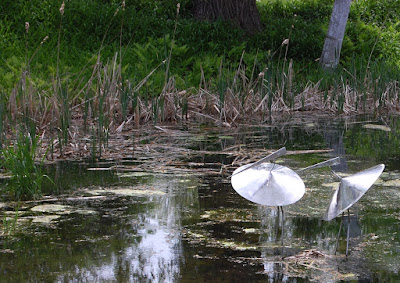 |
| George Sherwood, Memory of Water, 2014. Stainless steel, 78 x 78 x 78 in. Photo by Addison Zinner |
George Sherwood is the artist and engineer behind the stainless steel sculptures peppered throughout the Museum grounds. The sculptures play with the concepts of space, time, and movement, provoking viewers to interpret each of the pieces differently. Sherwood’s work is highly influenced by the motion of nature, symbolizing the shimmering of sun rays through tree leaves, the shine of the light on the scales of a fish, the movement of waves, and the flight and migrant patterns of birds.
Sherwood’s piece Turns, which can be found at the Museum duck pond, is counter weighted by small turns that hide under the “feathers” of the two metal birds, invisible to onlookers but accurate to their representation of nature.
 |
| George Sherwood, Turns, 2015. Stainless steel, 36 x 18 x 24 in. Photo by Addison Zinner |
|
Memory of Fibonacci, the circular piece that hangs on the wall of the Round Barn, was initially inspired by the mathematical Fibonacci sequence, seen in the center of a sunflower. Mixing organic ideas with inorganic creation, Sherwood’s art mimics the structure and gestures of objects and creatures found in nature.
 |
| George Sherwood, Memory of Fibonacci, 2014. Stainless steel, 60 x 60 x 5 in. Photo by Addison Zinner |
|
George Sherwood received an engineering and arts degree from the University of Vermont and the Hartford Art School. He currently lives, works, and creates in Ipswich, MA. The Vermont landscape and his relationship to the area as a student at UVM gave him the perfect context to exhibit his work at Shelburne Museum.
Join George Sherwood on May 28th at 2:00pm for his presentation at the Pizzagalli Center for Art and Education, followed by a walk through of his sculptures on the museum grounds. The eight alluring sculptures in his show Winds, Waves, and Light: Kinetic Sculpture by George Sherwood will be on display at Shelburne Museum through October 31, 2016. More information on George Sherwood and his work can be found on his website and the Shelburne Museum page.
 |
George Sherwood, Wind Sphere, 2002. Stainless steel, 168 x 72 x 72 in. Photo by Addison Zinner
|
|
Article by Addison Zinner







